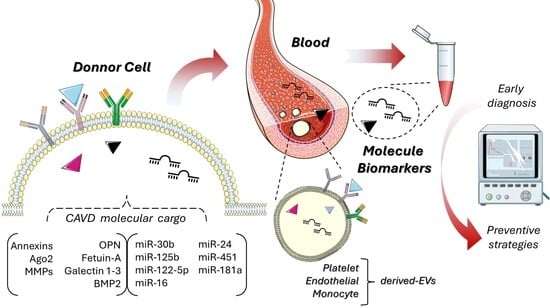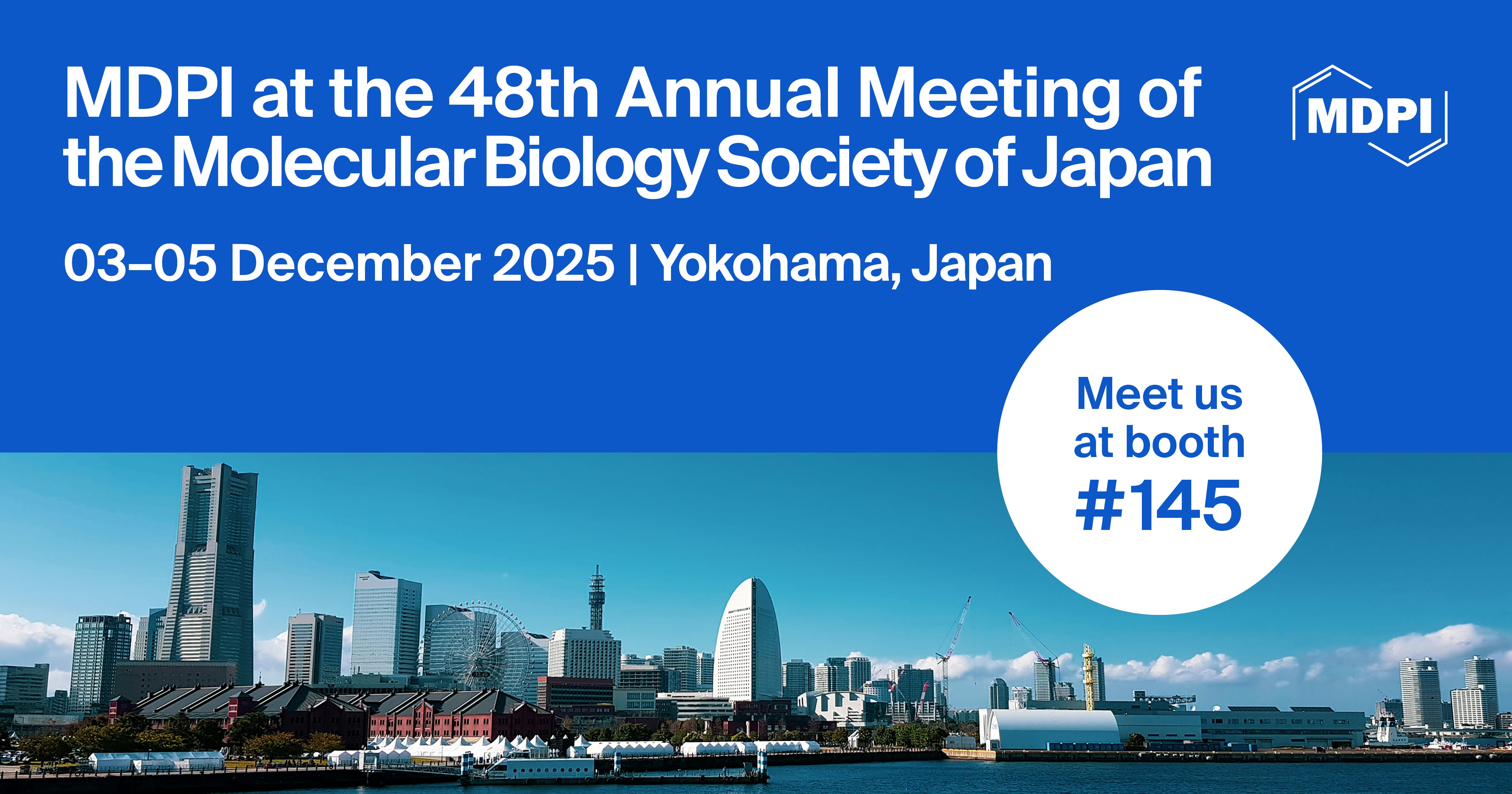-
 The Oxygen Dependency of Fibrinogen-Mediated Platelet Activation via αIIbβ3
The Oxygen Dependency of Fibrinogen-Mediated Platelet Activation via αIIbβ3 -
 Neurotropic Viruses as Acute and Insidious Drivers of Aging
Neurotropic Viruses as Acute and Insidious Drivers of Aging -
 The α5-α6-α7-Pba3-Pba4 Complex: A Starting Unit in Proteasome Core Particle Assembly
The α5-α6-α7-Pba3-Pba4 Complex: A Starting Unit in Proteasome Core Particle Assembly -
 Modeling Human Cell Death Pathways in Budding Yeast
Modeling Human Cell Death Pathways in Budding Yeast -
 Salivary MicroRNAs as Non-Invasive Biomarkers for Endometriosis and Therapy Response
Salivary MicroRNAs as Non-Invasive Biomarkers for Endometriosis and Therapy Response
Journal Description
Biomolecules
Biomolecules
is a peer-reviewed, open access journal on structures and functions of bioactive and biogenic substances, molecular mechanisms with biological and medical implications as well as biomaterials and their applications. Biomolecules is published monthly online by MDPI.
- Open Access— free for readers, with article processing charges (APC) paid by authors or their institutions.
- High Visibility: indexed within Scopus, SCIE (Web of Science), PubMed, MEDLINE, PMC, Embase, CAPlus / SciFinder, and other databases.
- Journal Rank: JCR - Q1 (Biochemistry and Molecular Biology) / CiteScore - Q1 (Biochemistry)
- Rapid Publication: manuscripts are peer-reviewed and a first decision is provided to authors approximately 19.4 days after submission; acceptance to publication is undertaken in 2.9 days (median values for papers published in this journal in the first half of 2025).
- Recognition of Reviewers: reviewers who provide timely, thorough peer-review reports receive vouchers entitling them to a discount on the APC of their next publication in any MDPI journal, in appreciation of the work done.
- Sections: published in 15 topical sections.
- Testimonials: See what our editors and authors say about Biomolecules.
- Companion journal: Receptors.
Impact Factor:
4.8 (2024);
5-Year Impact Factor:
5.6 (2024)
Latest Articles
Extracellular Vesicles in Calcific Aortic Valve Disease: From Biomarkers to Drug Delivery Applications
Biomolecules 2025, 15(11), 1548; https://doi.org/10.3390/biom15111548 - 4 Nov 2025
Abstract
Calcific aortic valve disease (CAVD) is a progressive disorder where molecular alterations occur long before visible calcification, making early biomarkers essential. Extracellular vesicles (EVs) have gained attention as stable biomarkers due to their lipid bilayer, which protects proteins, lipids, and RNAs, ensuring reliable
[...] Read more.
Calcific aortic valve disease (CAVD) is a progressive disorder where molecular alterations occur long before visible calcification, making early biomarkers essential. Extracellular vesicles (EVs) have gained attention as stable biomarkers due to their lipid bilayer, which protects proteins, lipids, and RNAs, ensuring reliable detection even in archived samples. This review highlights the role of EVs as biomarkers and delivery tools in CAVD. EVs derived from valvular endothelial, interstitial, and immune cells carry disease-specific signatures, including osteogenic proteins (BMP-2, Annexins), inflammatory miRNAs (miR-30b, miR-122-5p), and lipid mediators. These reflect early pathogenic processes before macroscopic calcification develops. Their presence in minimally invasive samples such as blood, urine, or saliva facilitates diagnosis, while their stability supports long-term monitoring of disease progression and therapeutic response. Advances in purification and single-EV analysis increase specificity, though challenges remain in standardizing methods and distinguishing CAVD-derived EVs from those in atherosclerosis. Beyond diagnostics, engineered EVs show promise as therapeutic carriers. Delivery of anti-calcific miRNAs or combined RNA cargos has reduced calcification and inflammation in preclinical models. Overall, EVs act as molecular mirrors of CAVD, enabling early diagnosis, risk stratification, and novel therapeutic strategies. Yet, clinical translation requires technical refinement and validation of the disease-specific signatures.
Full article
(This article belongs to the Special Issue Molecular and Cellular Mechanisms of Aortic Diseases)
►
Show Figures
Open AccessArticle
Kmt2c/Mll3 Haploinsufficiency Causes Autism-like Behavioral Deficits in Mice
by
Kaijie Ma, Maria Webb, Haniya Hayder and Luye Qin
Biomolecules 2025, 15(11), 1547; https://doi.org/10.3390/biom15111547 - 4 Nov 2025
Abstract
KMT2C (histone lysine N-methyltransferase 2C, also known as MML3, myeloid/lymphoid or mixed-lineage leukemia 3) is a causal gene for Kleefstra syndrome 2, a rare neurodevelopmental disorder. Recent human genetic studies have identified it as a high-risk gene for autism spectrum disorder (ASD),
[...] Read more.
KMT2C (histone lysine N-methyltransferase 2C, also known as MML3, myeloid/lymphoid or mixed-lineage leukemia 3) is a causal gene for Kleefstra syndrome 2, a rare neurodevelopmental disorder. Recent human genetic studies have identified it as a high-risk gene for autism spectrum disorder (ASD), with 79% of patients harboring KMT2C variants having ASD. However, the causal link between KMT2C haploinsufficiency and ASD remains unclear. KMT2C/MLL3 encodes a histone methyltransferase, a core protein of the KMT2C/D COMPASS (complex proteins associated with Set1) complex, which plays fundamental roles in chromatin modification, occupancy, and gene expression. The expression of KMT2C/Kmt2c peaks during the developmental period in the human/mouse brain, which indicates the critical roles of KMT2C/Kmt2c in neurodevelopment. Here, we investigated the impact of germline Kmt2c haploinsufficiency on autism-like behavioral deficits in mice, which modeled humans carrying diverse KMT2C variants. Compared with Kmt2c+/+ controls, Kmt2c haploinsufficiency mice had normal motor function without anxiety-like behaviors. Notably, Kmt2c haploinsufficiency mice exhibited autism-like social deficits and increased self-grooming in both males and females, which recapitulated the core phenotypes of ASD patients. Novel object recognition and spatial memory deficits were observed in male and female Kmt2c haploinsufficiency mice. This study reveals a causal link between Kmt2c haploinsufficiency and ASD-like behavioral deficits. These germline Kmt2c haploinsufficiency mice can be used for further studying the molecular mechanisms and developing therapeutic interventions for KMT2C haploinsufficiency-associated behavioral deficits.
Full article
(This article belongs to the Special Issue New Insight into the Molecular Genetics of Neurodevelopmental Disorders)
►▼
Show Figures
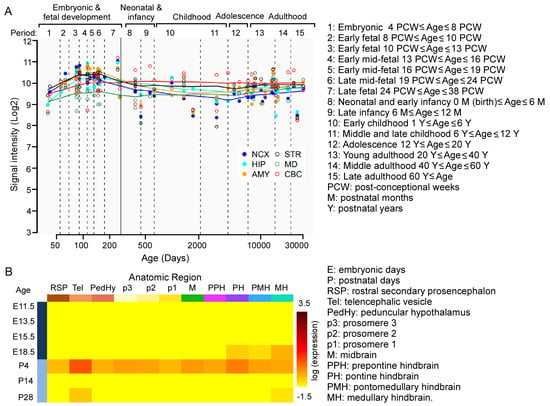
Figure 1
Open AccessReview
Gut Microbiota and Ferroptosis in Colorectal Cancer: A Comprehensive Review of Mechanisms and Therapeutic Strategies to Overcome Immune Checkpoint Resistance
by
Yingchang Cai, Feng Zhao and Xiaofei Cheng
Biomolecules 2025, 15(11), 1546; https://doi.org/10.3390/biom15111546 - 3 Nov 2025
Abstract
Colorectal cancer (CRC) remains a leading cause of cancer-related mortality worldwide. Although immune checkpoint inhibitors (ICIs) have achieved striking clinical efficacy in the subset of CRCs with mismatch repair deficiency/high microsatellite instability (dMMR/MSI-H), the vast majority of patients—those with proficient mismatch repair/microsatellite-stable (pMMR/MSS)
[...] Read more.
Colorectal cancer (CRC) remains a leading cause of cancer-related mortality worldwide. Although immune checkpoint inhibitors (ICIs) have achieved striking clinical efficacy in the subset of CRCs with mismatch repair deficiency/high microsatellite instability (dMMR/MSI-H), the vast majority of patients—those with proficient mismatch repair/microsatellite-stable (pMMR/MSS) tumors—derive little benefit from current immunotherapies. Ferroptosis, an iron-dependent form of regulated cell death driven by lethal accumulation of lipid peroxides, has emerged as a promising antitumor mechanism that can interact with and modulate antitumor immunity. Concurrently, the gut microbiota exerts powerful control over host metabolism and immune tone through microbial community structure and metabolite production; accumulating evidence indicates that microbiota-derived factors can either sensitize tumors to ferroptosis (for example, via short-chain fatty acids) or confer resistance (for example, indole-3-acrylic acid produced by Peptostreptococcus anaerobius acting through the AHR→ALDH1A3→FSP1/CoQ axis). In this review we synthesize mechanistic data linking microbial ecology, iron and lipid metabolism, and immune regulation to ferroptotic vulnerability in CRC. We discuss translational strategies to exploit this “microbiota–ferroptosis” axis—including precision microbiome modulation, dietary interventions, pharmacologic ferroptosis inducers, and tumor-targeted delivery systems—and we outline biomarker frameworks and trial designs to evaluate combinations with ICIs. We also highlight major challenges, such as interindividual microbiome variability, potential collateral harm to ferroptosis-sensitive immune cells, adaptive antioxidant compensation (e.g., NRF2/FSP1 activation), and safety/regulatory issues for live biotherapeutics. In summary, this review highlights that targeting the microbiota-ferroptosis axis may represent a rational and potentially transformative approach to reprogramming the tumor microenvironment and overcoming immune checkpoint resistance in pMMR/MSS colorectal cancer; however, further research is essential to validate this concept and address existing challenges.
Full article
(This article belongs to the Special Issue Colorectal and Gastric Cancers: Molecular Mechanisms and Potential Biomarkers)
►▼
Show Figures

Figure 1
Open AccessArticle
Expression Patterns of Interferons and Proinflammatory Cytokines in the Upper Respiratory Tract of Patients Infected by Different Viral Pathogens: Correlation with Age and Viral Load
by
Roberto Ferrarese, Federica Novazzi, Gabriele Arcari, Angelo Genoni, Francesca Drago Ferrante, Nicola Clementi, Serena Messali, Antonino Maria Guglielmo Pitrolo, Francesca Caccuri, Antonio Piralla, Arnaldo Caruso, Fausto Baldanti and Nicasio Mancini
Biomolecules 2025, 15(11), 1545; https://doi.org/10.3390/biom15111545 - 3 Nov 2025
Abstract
Respiratory tract infections are a major cause of morbidity and mortality. After the SARS-CoV-2 pandemic, pathogenetic mechanisms leading to more severe outcomes were investigated, including uncontrolled viral replication in the upper airways. This was only partially investigated for other respiratory viruses. We measured
[...] Read more.
Respiratory tract infections are a major cause of morbidity and mortality. After the SARS-CoV-2 pandemic, pathogenetic mechanisms leading to more severe outcomes were investigated, including uncontrolled viral replication in the upper airways. This was only partially investigated for other respiratory viruses. We measured mucosal expression of IFN-β1, IFN-λ1, IFN-λ2/3, IL-1β, and IL-6 in patients infected by human metapneumovirus, human rhinovirus, human respiratory syncytial virus or type A influenza virus. A total of 806 nasopharyngeal swabs were collected from patients presenting at emergency departments or hospitalized. Viral load was inferred through cycle threshold determination, whereas cytokine levels were measured through mRNA detection. Each expression pattern was correlated with age, viral load, and specific infecting virus. IFN-β1 and IFN-λ2/3 showed a negative correlation with viral load, while IFN-λ1 and IL-6 exhibited the opposite trend, suggesting increased inflammation with higher viral load. This was more evident in the ≥70-year-old group, with significantly higher IL-6 levels. Higher viral load of potentially more pathogenic viruses was associated with higher IL-6 expression. Cytokine production in the upper respiratory tract is only partially influenced by age per se, with a more relevant role played by viral load and specific infecting virus. In older patients, this response is less coordinated and prone to elicit a proinflammatory response, especially when clinically impacting viruses are involved.
Full article
(This article belongs to the Special Issue Dysregulated Cytokine Signals in Human Disease)
►▼
Show Figures

Figure 1
Open AccessReview
The Impact of Glycaemic Variability on Vascular Dysfunction in Diabetes
by
Laura J. Offler, Liz K. Wells and Timothy M. Palmer
Biomolecules 2025, 15(11), 1544; https://doi.org/10.3390/biom15111544 - 3 Nov 2025
Abstract
It is well established that vascular dysfunction is common in people with diabetes mellitus and is associated with increased risk of heart attack, ischaemic stroke and peripheral vascular disease. Although our understanding of the molecular mechanisms responsible is incomplete, persistent hyperglycaemia observed in
[...] Read more.
It is well established that vascular dysfunction is common in people with diabetes mellitus and is associated with increased risk of heart attack, ischaemic stroke and peripheral vascular disease. Although our understanding of the molecular mechanisms responsible is incomplete, persistent hyperglycaemia observed in poorly controlled diabetes has long been thought to be a critical factor. Multiple studies have, therefore, investigated the effects of poor glycaemic control on vascular function in multiple experimental settings, from in vitro and ex vivo models of primary human cells and tissues through to pre-clinical models. This review consolidates our current understanding of how metabolic and cell signalling pathways triggered by poor glycaemic control, impact vascular function in diabetes. We also evaluate how these pathways could be exploited to develop targeted therapeutic approaches to improve cardiovascular outcomes specifically in people with diabetes.
Full article
(This article belongs to the Collection Feature Papers in Section 'Molecular Medicine')
►▼
Show Figures
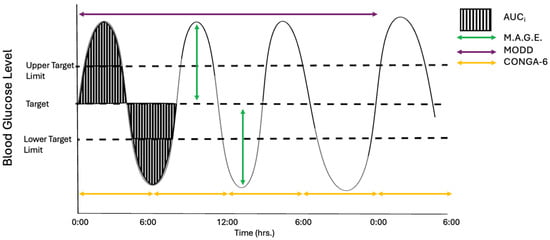
Figure 1
Open AccessReview
Critical Evaluation of the Role of Transcription Factor RAR-Orphan Receptor-γt in the Development of Chronic Inflammatory Dermatological Diseases: A Promising Therapeutic Target
by
Anik Pramanik, Pallabi Mondal and Sankar Bhattacharyya
Biomolecules 2025, 15(11), 1543; https://doi.org/10.3390/biom15111543 - 2 Nov 2025
Abstract
Nuclear receptors (NRs) are transcription factors regulated by ligands that direct metabolism, development, and immunity. The NR superfamily constitutes a principal category of pharmacological targets for human ailments. Retinoic acid receptor-related orphan receptors (RORs) α, β, and γ are part of the nuclear
[...] Read more.
Nuclear receptors (NRs) are transcription factors regulated by ligands that direct metabolism, development, and immunity. The NR superfamily constitutes a principal category of pharmacological targets for human ailments. Retinoic acid receptor-related orphan receptors (RORs) α, β, and γ are part of the nuclear receptor superfamily. They are nevertheless classified as “orphan” receptors due to the contentious nature of identifying their endogenous ligands. RORγ nuclear receptor protein further consists of two isoforms, namely RORγ1 and RORγ2 or RORγt. RORγt is largely found in immune cells and has been primarily associated with chronic inflammatory conditions. The expression of STAT3 is a major driver of Th17 differentiation and induces RORγt expression through the JAK-STAT pathway. Type 3 innate lymphoid cells (ILC3s), Th17 cells, and γδT cells express RORγt, the master transcription regulator for the pro-inflammatory cytokine interleukin IL-17. In chronic inflammatory skin disorders, a significant increase in IL-17 has been observed, which plays a key role in both immune cell recruitment to the site of inflammation and the propagation of tissue damage. In this review, we will discuss how RORγt regulates IL-17-driven inflammation and explore potential strategies to target the RORγt-IL-17 axis as a viable therapeutic intervention in chronic inflammatory skin disorders.
Full article
(This article belongs to the Special Issue Transcription Factors in Hematopoiesis and Immunity: From Development to Therapeutic Targeting)
►▼
Show Figures

Graphical abstract
Open AccessArticle
Within- and Between-Subject Analyses of the Effects of Chronic Xylazine on Negative Phototaxis in Two Planarian Species
by
Tom Byrne
Biomolecules 2025, 15(11), 1542; https://doi.org/10.3390/biom15111542 - 2 Nov 2025
Abstract
Xylazine, an adulterant found frequently in illicit fentanyl, has been implicated in causing several adverse effects in human recreational users, including skin lesions and complications in the treatment of opiate overdose. Despite these public health concerns, the literature on the basic behavioral effects
[...] Read more.
Xylazine, an adulterant found frequently in illicit fentanyl, has been implicated in causing several adverse effects in human recreational users, including skin lesions and complications in the treatment of opiate overdose. Despite these public health concerns, the literature on the basic behavioral effects of xylazine is limited. Recent research has demonstrated that planarians show potential as an emerging and practical animal model for studying the behavioral effects of acute xylazine exposure. The goal of the current investigation was to evaluate the behavioral effects of chronic xylazine administration on negative phototaxis in two planarian species: Girardia tigrina and Schmidtea mediterranea. Three experiments were conducted. Overall, 10 µM of chronic xylazine exposure, arranged according to a multiple-baseline design, impaired negative phototaxis in S. mediterranea but not G. tigrina. An ABA reversal design indicated that behavioral effects in S. mediterranea abated when chronic xylazine was terminated. Finally, a between-group design replicated potential interspecies differences when G. tigrina and S. mediterranea were compared directly, with the latter showing significantly greater susceptibility to drug effects. This work provides evidence of the utility of a planarian model for studying the behavioral effects of xylazine and lays the foundation for further investigation into the chronic effects of the drug.
Full article
(This article belongs to the Special Issue The Planarian Model in Pharmacology, Toxicology, and Neuroscience)
►▼
Show Figures

Figure 1
Open AccessReview
Advances in Understanding Renin–Angiotensin System-Mediated Anti-Tumor Activity of Natural Polyphenols
by
Ximing Wu, Mingchuan Yang, Hailing Zhang, Lumin Yang, Yufeng He, Xiaozhong Cheng and Guilan Zhu
Biomolecules 2025, 15(11), 1541; https://doi.org/10.3390/biom15111541 - 2 Nov 2025
Abstract
The imbalance of the renin–angiotensin system (RAS), characterized by the overactivation of the pro-tumor ACE/AngII/AT1R axis, is closely linked to tumor growth, angiogenesis, metastasis, and poor prognosis. Natural polyphenols, such as EGCG and resveratrol, exert anti-cancer effects by dual-regulating RAS: they inhibit the
[...] Read more.
The imbalance of the renin–angiotensin system (RAS), characterized by the overactivation of the pro-tumor ACE/AngII/AT1R axis, is closely linked to tumor growth, angiogenesis, metastasis, and poor prognosis. Natural polyphenols, such as EGCG and resveratrol, exert anti-cancer effects by dual-regulating RAS: they inhibit the pro-tumor axis by blocking renin, ACE activity, and AT1R expression, while simultaneously activating the protective ACE2/Ang(1-7)/MasR axis. Furthermore, polyphenols and their autoxidation products (e.g., EAOP) modify thiol-containing transmembrane proteins (such as ADAM17 and integrins) and interact with RAS components, further disrupting oncogenic pathways (including MAPK and PI3K/Akt/mTOR) to induce apoptosis, suppress invasion, and reduce oxidative stress. Notably, EAOP exhibits stronger RAS-modulating efficacy than its parent polyphenols. However, challenges such as low bioavailability, insufficient targeting, and limited clinical evidence impede their application. This review provides a comprehensive overview of the anti-cancer mechanisms of polyphenols through RAS regulation, discusses the associated challenges, and proposes potential solutions (including nanodelivery and structural modification) and strategies to advance natural product-based adjuvant treatments.
Full article
(This article belongs to the Section Molecular Medicine)
►▼
Show Figures
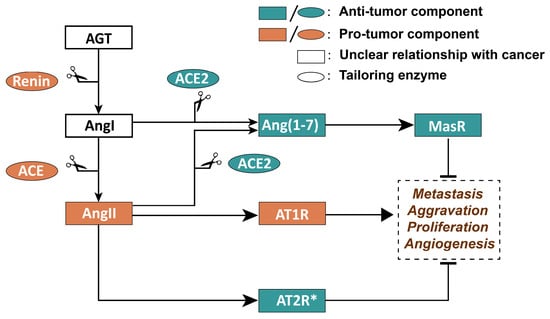
Figure 1
Open AccessArticle
Hapten-Specific Cellular Immune Responses in the Elicitation and Sensitization Phases of Murine Contact Hypersensitivity
by
Kornél Molnár, Gábor Kovács, Bence Kormos, Petra Aradi and Zoltán Jakus
Biomolecules 2025, 15(11), 1540; https://doi.org/10.3390/biom15111540 - 1 Nov 2025
Abstract
Contact dermatitis (CD) is a common inflammatory skin condition with irritant etiology or a delayed-type hypersensitivity called allergic contact dermatitis (ACD). Contact hypersensitivity (CHS) is a widely used rodent model of ACD and similarly consists of two phases: sensitization and elicitation. To trigger
[...] Read more.
Contact dermatitis (CD) is a common inflammatory skin condition with irritant etiology or a delayed-type hypersensitivity called allergic contact dermatitis (ACD). Contact hypersensitivity (CHS) is a widely used rodent model of ACD and similarly consists of two phases: sensitization and elicitation. To trigger CHS, low-molecular-weight haptens, such as DNFB or TNCB, are commonly applied. However, the characterization of the induced immune response remains incomplete. Our aim was to characterize the immune response after first and repeated exposures to model haptens. First exposure to DNFB or TNCB led to significant ear swelling, with DNFB causing a more pronounced effect. DNFB enhanced neutrophil infiltration, whereas TNCB led to macrophage, dendritic cell, and helper T cell accumulation. Repeated DNFB exposure did not aggravate edema significantly, while TNCB re-exposure enhanced edema formation and induced neutrophil granulocyte, dendritic cell, and helper and cytotoxic T cell accumulation. Our results demonstrate that a hapten-specific immune response is induced during both phases of CHS. A detailed understanding of allergen-specific immune responses is crucial for the appropriate selection of the model and for gaining deeper insight into the mechanisms of inflammatory skin diseases. These findings may contribute to the targeted selection of haptens.
Full article
(This article belongs to the Section Molecular Medicine)
►▼
Show Figures

Figure 1
Open AccessArticle
Effects of Bile on Pathogenic Vibrio, Aeromonas, and Clostridioides spp. Toxin Effector Domains
by
Jaylen E. Taylor, David B. Heisler, Eshan Choudhary, Elena Kudryashova and Dmitri S. Kudryashov
Biomolecules 2025, 15(11), 1539; https://doi.org/10.3390/biom15111539 - 1 Nov 2025
Abstract
Bile acids, the primary components of bile, are cholesterol-derived molecules synthesized in the liver and secreted to the small intestine. Besides their primary digestive roles, bile acids have antimicrobial properties and serve as an environmental cue for intestinal pathogens, modulating the expression of
[...] Read more.
Bile acids, the primary components of bile, are cholesterol-derived molecules synthesized in the liver and secreted to the small intestine. Besides their primary digestive roles, bile acids have antimicrobial properties and serve as an environmental cue for intestinal pathogens, modulating the expression of virulence factors, e.g., toxins and effector proteins. Whereas timely recognition and neutralization of pathogenic toxin effectors by the host is critical, our understanding of the effects of bile on their structure and function is limited. In this work, we found that bile effectively protected cultured IEC-18 enterocytes from the mixture of Aeromonas hydrophila secreted toxins, containing hemolysin, aerolysin, and RtxA (MARTX). To explore whether these effects have broad specificity, we employed biochemical and biophysical techniques to test the in vitro effects of bile and bile acids on several effector domains of MARTX and VgrG toxins from Vibrio cholerae and Aeromonas hydrophila, and catalytic domains of TcdA and TcdB toxins from Clostridioides difficile. Bile compromised the structural integrity of the tested effectors to various degrees in a protein charge-dependent manner. Bile and bile acids promoted exposure of hydrophobic residues and the unfolding of most, but not all, of the tested effectors, facilitating their precipitation and cleavage by chymotrypsin. Bile also inhibited specific activities of the tested effector enzymes, partially due to imposed oxidation of their catalytic residues. To summarize, this work validated bile as a non-proteinaceous factor of innate immunity, capable of compromising the structural integrity and function of the effector domains of various bacterial toxins.
Full article
(This article belongs to the Section Biomacromolecules: Proteins, Nucleic Acids and Carbohydrates)
►▼
Show Figures

Graphical abstract
Open AccessArticle
Modeling the Mutational Effects on Biochemical Phenotypes of SARS-CoV-2 Using Molecular Fields
by
Baifan Wang and Zhen Xi
Biomolecules 2025, 15(11), 1538; https://doi.org/10.3390/biom15111538 - 31 Oct 2025
Abstract
The ongoing evolution of SARS-CoV-2 has given rise to variants with enhanced transmissibility and pathogenicity, many of which harbor mutations in the receptor-binding domain (RBD) of the viral spike protein. These mutations often confer increased viral fitness and immune evasion by modulating interactions
[...] Read more.
The ongoing evolution of SARS-CoV-2 has given rise to variants with enhanced transmissibility and pathogenicity, many of which harbor mutations in the receptor-binding domain (RBD) of the viral spike protein. These mutations often confer increased viral fitness and immune evasion by modulating interactions with the human ACE2 receptor (hACE2) and escaping neutralizing antibodies. Accurate prediction of the functional consequences of such mutations—particularly their effects on receptor binding and antibody escape—is critical for assessing the public health threat posed by emerging variants. In this study, we apply a Mutation-dependent Biomacromolecular Quantitative Structure–Activity Relationship (MB-QSAR) framework to quantitatively model the biochemical phenotypes of RBD variants. Trained on comprehensive deep mutational scanning (DMS) datasets, our models exhibit strong predictive performance, achieving correlation coefficients (r2) exceeding 0.8 for hACE2 binding affinity and 0.7 for antibody neutralization escape. Importantly, the MB-QSAR approach generalizes well to multi-mutant variants and currently circulating lineages. Structural analysis based on model-derived interaction profiles offers mechanistic insights into key RBD–ACE2 and RBD–antibody interfaces, helping the rational design of broadly protective vaccines and therapeutics. This work establishes MB-QSAR as a rapid, accurate, and interpretable tool for the prediction of protein–protein interaction and forecasting viral adaptation, thereby facilitating early risk assessment of novel SARS-CoV-2 variants.
Full article
(This article belongs to the Section Molecular Biophysics: Structure, Dynamics, and Function)
►▼
Show Figures

Figure 1
Open AccessArticle
Free Fatty Acids Correlate with the Interleukin-1 β and Interleukin-1 Receptor Antagonist in the Early Subacute Phase of Stroke
by
Dariusz Kotlega, Arleta Drozd, Agnieszka Zembron-Lacny, Barbara Morawin, Karina Ryterska and Malgorzata Szczuko
Biomolecules 2025, 15(11), 1537; https://doi.org/10.3390/biom15111537 - 31 Oct 2025
Abstract
Inflammation contributes to the pathogenesis of ischaemic stroke both as a long-term causal factor and through the inflammatory cascade in acute stroke. Interleukin-1 beta (IL-1β) is a potent pro-inflammatory molecule, while interleukin-1 receptor antagonist (IL-1Ra) acts as its antagonist. Free fatty acids (FFAs)
[...] Read more.
Inflammation contributes to the pathogenesis of ischaemic stroke both as a long-term causal factor and through the inflammatory cascade in acute stroke. Interleukin-1 beta (IL-1β) is a potent pro-inflammatory molecule, while interleukin-1 receptor antagonist (IL-1Ra) acts as its antagonist. Free fatty acids (FFAs) play a role in atherosclerosis formation and serve as substrates for inflammatory molecules. This study aimed to determine the potential interplay between FFAs, IL-1β, and IL-1Ra in stroke patients. A prospective analysis was conducted on 73 ischaemic stroke patients. All participants had their FFA, IL-1β, and IL-1Ra levels assessed. Significant correlations between IL-1β and certain FFAs were detected: C15:0 pentadecanoic acid (rho = 0.488), C15:1 cis-10 pentadecanoic acid (rho = 0.473), C17:1 cis-10 heptadecanoic acid (rho = 0.411), C18:0 stearic acid (rho = 0.302), C24:0 lignoceric acid (rho = −0.280), C24:1 nervonic acid (rho = −0.276), C18:2n6t linoleic acid (rho = −0.272), C17:0 heptadecanoic acid (rho = 0.241), and C13:0 tridecanoic acid (rho = 0.238). After multivariate analysis C15:0 pentadecanoic acid remained statistically significant. The strongest correlation was found between IL-1Ra and fatty acids: C15:1 cis-10-pentadecanoid acid (rho = −0.357), C18:2n6t linoleic acid (rho 0.341) and C24:1 nervonic acid (rho 0.302), but after multivariate analysis significantly correlated remained: C22:1n9 13 erucic acid (rho = 0.299), C18:3n6 gamma-linoleic acid (rho = 0.277), with close to significant correlation with C22:4n6 docosatetraenoate (rho = −0.241, p = 0.055). Certain FFAs may play a role in enhancing both pro- and anti-inflammatory responses in the early subacute phase of stroke, where inflammatory and resolving processes are ongoing. Fatty acids such as C15:0 pentadecanoic acid, C15:1 cis-10 pentadecanoic acid and C22:4n6 docosatetraenoate might be involved in pro-inflammatory responses, while C22:1n9 13 erucic acid and C18:3n6 gamma-linoleic acid in the anti-inflammatory pathways with the overlay of IL-1β and IL-1Ra.
Full article
(This article belongs to the Special Issue Molecular Mechanisms and Novel Treatments of Stroke)
►▼
Show Figures

Figure 1
Open AccessReview
Neuroendocrine–Immune Axis in Endometriosis: A Review on How the Nervous System Goes Beyond Pain Perception
by
Lingyu Chang, Jing Shan, Dajin Li and Xiaoqiu Wang
Biomolecules 2025, 15(11), 1536; https://doi.org/10.3390/biom15111536 - 31 Oct 2025
Abstract
Endometriosis (EMS) is an estrogen-dependent disorder that affects about 10% of reproductive-age women. EMS affects female neuroendocrine and reproductive functions, greatly compromising female reproductive health and quality of life. However, the pathogenesis of EMS has not been fully elucidated, and effective treatment options
[...] Read more.
Endometriosis (EMS) is an estrogen-dependent disorder that affects about 10% of reproductive-age women. EMS affects female neuroendocrine and reproductive functions, greatly compromising female reproductive health and quality of life. However, the pathogenesis of EMS has not been fully elucidated, and effective treatment options are still lacking. The neuroendocrine–immune axis can achieve cross-regulation through the interaction of neurotransmitters, hormone-like substances, cytokines, and their receptors to maintain body homeostasis, and this imbalance of regulation is involved in the occurrence and development of EMS. In this narrative review, we summarize recent progress on the role of the neuroendocrine–immune axis in the pathogenesis of endometriosis, as well as the emergence of novel therapies targeting this axis. This review aims to offer a novel perspective for the in-depth exploration of EMS pathogenesis and the identification of potential effective treatments.
Full article
(This article belongs to the Special Issue Human Reproductive Biology: Uncertainties and Controversies)
►▼
Show Figures
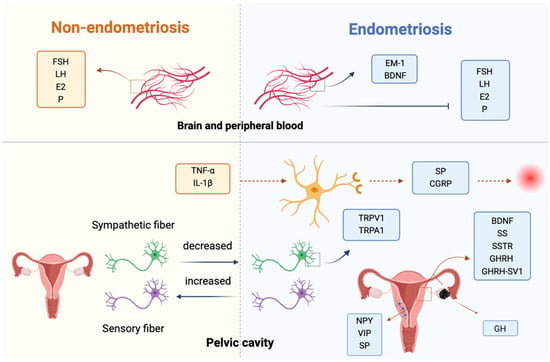
Figure 1
Open AccessReview
The Potential Role of Microalgal Antioxidant Molecules on the Microbiota–Gut Axis in Inflammatory Bowel Diseases
by
Rosa Paola Radice, Valeria Iannelli, Francesca Padula, Vincenzo De Fabrizio, Marios Drosos, Antonio Scopa and Giuseppe Martelli
Biomolecules 2025, 15(11), 1535; https://doi.org/10.3390/biom15111535 - 31 Oct 2025
Abstract
Comprising multiple microorganisms, the microbiota plays a crucial role in regulating the immune system and maintaining homeostasis. The influence of genetic and environmental factors causes the composition of the microbiota to change throughout life, which is called the plasticity of the microbiota. A
[...] Read more.
Comprising multiple microorganisms, the microbiota plays a crucial role in regulating the immune system and maintaining homeostasis. The influence of genetic and environmental factors causes the composition of the microbiota to change throughout life, which is called the plasticity of the microbiota. A eubiotic microbiota promotes the immune response, reducing the risk of inflammation and diseases such as IBD and cancer. The Mediterranean diet is of fundamental importance for a healthy microbiota. On the contrary, Western diets lead to microbiota dysbiosis and inflammation. Microalgae, and, in particular, their derivatives, show promise and relevance in the search for potential anti-inflammatory and antioxidant biomolecules. This review focuses on the correlation between microbiota, nutrition, immunity and microalgal derivatives, highlighting how these may be a potential innovative therapeutic strategy for the management of chronic inflammatory diseases.
Full article
(This article belongs to the Special Issue Recent Advances in Bioactive Compounds from Microalgae)
►▼
Show Figures

Figure 1
Open AccessArticle
Integrating 3D Osteocyte Culture, Microgravity Simulation, and Fluid Flow Reveals Mechanisms of Osteocyte Mechanosensation and Calcium Signaling Altered by Disuse
by
Kanglun Yu, Anik Tuladhar, Samuel Dankberg, Caihong Dai and Meghan E. McGee-Lawrence
Biomolecules 2025, 15(11), 1534; https://doi.org/10.3390/biom15111534 - 31 Oct 2025
Abstract
Osteocytes translate fluid shear stress into biochemical signals critical for bone homeostasis. Here, we combined 3-dimensional (3D) osteocyte culture, microgravity simulation, fluid shear mimicking reloading after disuse, and real-time calcium signaling analysis to elucidate responses of osteocytes under different mechanical environments. Ocy454 cells
[...] Read more.
Osteocytes translate fluid shear stress into biochemical signals critical for bone homeostasis. Here, we combined 3-dimensional (3D) osteocyte culture, microgravity simulation, fluid shear mimicking reloading after disuse, and real-time calcium signaling analysis to elucidate responses of osteocytes under different mechanical environments. Ocy454 cells were seeded onto 3D scaffolds and cultured under static (control) or simulated microgravity (disuse) conditions using a rotating wall vessel bioreactor. Elevated expression levels of Sost, Tnfsf11 (Rankl), and Dkk1 were detected following disuse, confirming efficacy of the microgravity model. Cell membrane integrity under mechanical challenge was evaluated by subjecting scaffold cultures to fluid shear in medium containing FITC-conjugated dextran (10 kDa). The proportion of dextran-retaining cells, indicative of transient membrane disruption and subsequent repair, was higher in microgravity-exposed osteocytes than controls, suggesting increased susceptibility to membrane damage upon reloading following disuse. Intracellular calcium signaling was assessed under a high but physiological fluid shear stress (30 dynes/cm2). Scaffolds cultured under disuse conditions demonstrated a larger sub-population of osteocytes with high calcium signaling intensity (F/Fo > 10 fold) during fluid shear. The maximum fold change in calcium signaling intensity over baseline and the duration of the peak calcium wave were greater for osteocytes cultured under disuse as compared to static controls, however the bioreactor-cultured osteocytes showed, on average, fewer calcium waves than those cultured under control conditions. Subsequent experiments demonstrated that the sub-population of osteocytes with high calcium signaling intensity following exposure to disuse were those that had experienced a transient membrane disruption event during reloading. Together, these results suggest that simulated microgravity enhances osteocyte susceptibility to formation of transient membrane damage and alters intracellular calcium signaling responses upon reloading. This integrated approach establishes a novel platform for mechanistic studies of osteocyte biology and could inform therapeutic strategies targeting skeletal disorders related to altered mechanical loading.
Full article
(This article belongs to the Special Issue Calcium Signaling and Transport in Health and Disease: Recent Developments and New Insights)
►▼
Show Figures

Figure 1
Open AccessArticle
Inflammatory Biomarkers for Thrombotic Risk Assessment in Multiple Myeloma Patients on IMiD/aCD38-Based Regimens: Insights from a Prospective Observational Study
by
Cirino Botta, Anna Maria Corsale, Claudia Cammarata, Fabiana Di Fazio, Emilia Gigliotta, Andrea Rizzuto, Manuela Ingrascì, Maria Speciale, Cristina Aquilina, Marta Biondo, Andrea Romano, Mariasanta Napolitano, Marta Mattana and Sergio Siragusa
Biomolecules 2025, 15(11), 1533; https://doi.org/10.3390/biom15111533 - 31 Oct 2025
Abstract
Thrombosis is a common complication in multiple myeloma (MM) patients treated with immunomodulatory drugs (IMiDs), including thalidomide, lenalidomide, and pomalidomide. When combined with anti-CD38 monoclonal antibodies, these agents are highly effective but may increase thrombotic events (TE), potentially delaying therapy. This exploratory, hypothesis-generating
[...] Read more.
Thrombosis is a common complication in multiple myeloma (MM) patients treated with immunomodulatory drugs (IMiDs), including thalidomide, lenalidomide, and pomalidomide. When combined with anti-CD38 monoclonal antibodies, these agents are highly effective but may increase thrombotic events (TE), potentially delaying therapy. This exploratory, hypothesis-generating analysis, conducted within the MMVision mono-institutional prospective study, included 53 MM patients who initiated IMiD plus anti-CD38 therapy between May 2021 and December 2022 (median follow-up: 18 months). Treatment regimens comprised lenalidomide (n = 36) or thalidomide (n = 15) with daratumumab, and pomalidomide (n = 2) with isatuximab. Most patients (n = 38) received frontline therapy, and all were given thromboprophylaxis according to guidelines, mainly aspirin (73%). Five patients (9.4%) developed VTE after a median of 48 days, managed with short-term low-molecular-weight heparin (LMWH). Exploratory analysis of 27 clinical/laboratory parameters suggested possible associations between VTE and low levels of beta-2 microglobulin, ferritin, intact/free lambda light chains, and monocyte-to-lymphocyte ratio. Notably, four of the five VTEs occurred in patients without lytic bone disease, typically associated with bone-driven inflammation in MM. Although all patients received aspirin prophylaxis from treatment initiation, it remains unclear whether thrombosis would also have occurred among those with higher inflammatory burden. These preliminary observations may indicate that in patients with relatively lower inflammation, aspirin prophylaxis could be less effective, potentially favoring VTE onset. In two VTE cases, cytokine profiling showed decreased M-CSF, SCLF-β, and MIP-1α, with increased G-CSF, raising the hypothesis of distinct immune-inflammatory pathways contributing to TEs. Given the limited number of patients and thrombotic events, and the cytokine data available for only two VTE cases, these associations should be regarded as exploratory and interpreted with caution. Overall, these exploratory findings warrant validation in larger, independent cohorts and may help generate hypotheses on how inflammatory signatures influence thrombotic risk and prophylaxis efficacy in MM patients receiving IMiD/anti-CD38-based regimens.
Full article
(This article belongs to the Special Issue Multiple Myeloma: From Pathophysiology to Novel Therapeutic Approaches)
►▼
Show Figures

Figure 1
Open AccessArticle
Comparative Evaluation of Mutect2, Strelka2, and FreeBayes for Somatic SNV Detection in Synthetic and Clinical Whole-Exome Sequencing Data
by
Igor López-Cade, Alicia Gómez-Sanz, Adrián Sanvicente, Cristina Díaz-Tejeiro, Aránzazu Manzano, Pedro Pérez-Segura, Balázs Győrffy, Alberto Ocaña, Miguel de la Hoya and Vanesa García-Barberán
Biomolecules 2025, 15(11), 1532; https://doi.org/10.3390/biom15111532 - 30 Oct 2025
Abstract
Somatic variant calling is a critical step in cancer genome analysis, but the performance of available tools can vary depending on their underlying algorithms and filtering strategies. We compared three widely used variant callers—Mutect2, Strelka2, and FreeBayes—for their performance in somatic single-nucleotide variant
[...] Read more.
Somatic variant calling is a critical step in cancer genome analysis, but the performance of available tools can vary depending on their underlying algorithms and filtering strategies. We compared three widely used variant callers—Mutect2, Strelka2, and FreeBayes—for their performance in somatic single-nucleotide variant (SNV) detection using both synthetic and real whole-exome sequencing (WES) data. Synthetic data were generated by introducing 4709 SNVs into a variant-free BAM file, while real data consisted of tumor and matched normal WES samples from five ovarian cancer (OC) patients. All callers were run using the nf-core/sarek pipeline with default settings and appropriate filtering. In the synthetic dataset, all tools showed high precision (~99.9%), with Mutect2 achieving the highest recall (63.1%), followed by Strelka2 (46.3%) and FreeBayes (45.2%). In real samples, FreeBayes detected the most variants, and only 5.1% of SNVs were shared across all three tools. We then integrated calls with SomaticSeq in consensus mode (Mutect2 + Strelka2) and kept variants with stronger allelic signals—showing higher VAFs and, typically, higher coverages relative to single-caller only. Caller-exclusive variants showed significant differences in allele frequency and sequencing depth. These results highlight substantial variability in SNV detection across tools. While all showed high specificity, differences in sensitivity and variant profiles underscore the need for context-specific caller selection or ensemble approaches in cancer genomics.
Full article
(This article belongs to the Special Issue Advances in Computational Approaches for the Discovery of Therapeutics and Personalized Medicine)
►▼
Show Figures
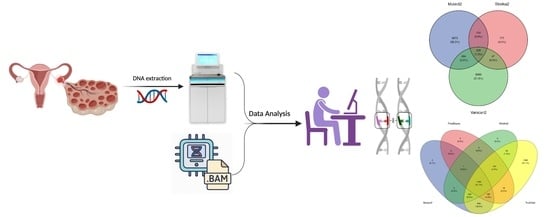
Graphical abstract
Open AccessArticle
Mitochondrial Genome Features and Phylogenetic Analyses of Four Chrysochroinae Species (Coleoptera: Buprestidae)
by
Jieqiong Wang, Yingying Li, Zhonghua Wei and Aimin Shi
Biomolecules 2025, 15(11), 1531; https://doi.org/10.3390/biom15111531 - 30 Oct 2025
Abstract
The number of known mitochondrial genomes in Buprestidae is limited, especially in Chrysochroinae, which seriously hinders the phylogenetic study of this family. The mitogenomes of Capnodis miliaris, Lamprodila cupreosplendens, Sphenoptera insidiosa and Philocteanus rubroaureus were sequenced, assembled and annotated in this
[...] Read more.
The number of known mitochondrial genomes in Buprestidae is limited, especially in Chrysochroinae, which seriously hinders the phylogenetic study of this family. The mitogenomes of Capnodis miliaris, Lamprodila cupreosplendens, Sphenoptera insidiosa and Philocteanus rubroaureus were sequenced, assembled and annotated in this study. The mitogenomes of these four species are typical circular double-stranded DNA molecules, containing 13 protein-coding genes (PCGS), 22 transfer RNA genes (tRNAs), 2 ribosomal RNA genes (rRNAs), and a control region (CR). The total lengths of these four mitogenomes are moderate, ranging from 15,778 bp to 16,230 bp. Additionally, their A + T content ranges from 68.76% to 73.47%, showing positive AT-skew values ranging from 0.098 to 0.181. Relative Synonymous Codon Usage (RSCU) analysis indicated that TTT (Phe), ATT (Ile), TCT (Ser2), and TTA (Leu2) are the most frequently used codons. The gene arrangement of four mitogenomes is consistent with the previously reported Buprestidae mitogenomes. Most of the PCGs use ATN as the start codon, with TAA as the stop codon or an incomplete stop codon T-. Phylogenetic trees were constructed based on the PCGs and rRNAs using both maximum-likelihood and Bayesian inference methods. The phylogenetic results showed that Julodinae, Polycestinae, Buprestinae and Agrilinae are monophyletic groups, and Chrysochroinae is a paraphyletic group. As the number of Buprestidae mitogenomes used for polyogenetic analysis increases, the topology of phylogenetic tree shows differences compared to previous studies.
Full article
(This article belongs to the Section Molecular Biology)
►▼
Show Figures

Figure 1
Open AccessReview
Beyond Processing: Furin as a Central Hub in Viral Pathogenesis and Genetic Susceptibility
by
Adrián Alejandro Silva-Ríos, Carlos Ernesto Mora-Ornelas, Luna Galilea Flores-Medina, José Francisco Muñoz-Valle, Carlos Daniel Díaz-Palomera, Mariel García-Chagollan, Alexis Missael Vizcaíno-Quirarte and Oliver Viera-Segura
Biomolecules 2025, 15(11), 1530; https://doi.org/10.3390/biom15111530 - 30 Oct 2025
Abstract
Furin, a calcium-dependent serine endoprotease of the proprotein convertase family, plays a pivotal role in both physiological homeostasis and viral pathogenesis. By cleaving polybasic motifs within viral glycoproteins, furin enables the maturation of structural proteins essential for viral entry, fusion, and replication. This
[...] Read more.
Furin, a calcium-dependent serine endoprotease of the proprotein convertase family, plays a pivotal role in both physiological homeostasis and viral pathogenesis. By cleaving polybasic motifs within viral glycoproteins, furin enables the maturation of structural proteins essential for viral entry, fusion, and replication. This mechanism has been documented across a broad spectrum of human pathogens, including SARS-CoV-2, influenza virus, human immunodeficiency virus, human papilloma virus, hepatitis B virus, flaviviruses, herpesviruses, and paramyxoviruses, highlighting furin as a conserved molecular hub in host–virus interactions. Genetic variability within the FURIN gene further modulates infection outcomes. Several single-nucleotide polymorphisms (SNPs), such as rs6226 and rs1981458, are associated with altered COVID-19 severity, whereas variants like rs17514846 confer protection against human papilloma virus infection. Conversely, mutations predicted to reduce enzymatic activity have been linked to attenuated SARS-CoV-2 pathogenesis in certain populations. These findings underscore the importance of considering population genetics when evaluating viral susceptibility and disease progression. Despite advances, unresolved questions remain regarding furin’s non-canonical roles in viral life cycles, tissue-specific regulation, and interactions with other host proteases and immune modulators. Targeted inhibition of furin and related convertases represents a promising avenue for broad-spectrum antiviral interventions. Collectively, current evidence positions furin as a central node at the intersection of viral pathogenesis, host genetic variability, and translational therapeutic potential.
Full article
(This article belongs to the Section Enzymology)
►▼
Show Figures

Figure 1
Open AccessArticle
Mining Thermophile Photosynthesis Genes: A Synthetic Operon Expressing Chloroflexota Species Reaction Center Genes in Rhodobacter sphaeroides
by
Yasir Rehman, Younghoon Kim, Michelle Tong, Ian K. Blaby, Crysten E. Blaby-Haas and J. Thomas Beatty
Biomolecules 2025, 15(11), 1529; https://doi.org/10.3390/biom15111529 - 30 Oct 2025
Abstract
Photosynthesis is the foundation of the vast majority of life systems, and is therefore the most important bioenergetic process on earth. The greatest diversity of photosynthetic systems is found in microorganisms. However, our understanding of the biophysical and biochemical processes that transduce light
[...] Read more.
Photosynthesis is the foundation of the vast majority of life systems, and is therefore the most important bioenergetic process on earth. The greatest diversity of photosynthetic systems is found in microorganisms. However, our understanding of the biophysical and biochemical processes that transduce light into chemical energy is derived from a relatively small subset of proteins from microbes that are amenable to cultivation, in contrast to the huge number of predicted proteins that catalyze the initial photochemical reactions deposited in databases, such as from metagenomics. We describe the use of a Rhodobacter sphaeroides laboratory strain for the expression of heterologous photosynthesis genes to demonstrate the feasibility of mining this resource, focusing on hot spring Chloroflexota gene sequences. Using a synthetic operon of genes, we produced a photochemically active complex of reaction center proteins in our biological system. We also present bioinformatic analyses of anoxygenic type II reaction center sequences from metagenomic samples collected from hot (42–90 °C) springs available through the JGI IMG database, to generate a resource of diverse sequences that are potentially adapted to photosynthesis at such temperatures. These data provide a view into the natural diversity of anoxygenic photosynthesis, through a lens focused on high-temperature environments. The approach we took to express such genes can be applied for potential biotechnology purposes as well as for studies of fundamental catalytic properties of these heretofore inaccessible protein complexes.
Full article
(This article belongs to the Special Issue New Insights into the Membranes of Anoxygenic Phototrophic Bacteria)
►▼
Show Figures

Figure 1

Journal Menu
► ▼ Journal Menu-
- Biomolecules Home
- Aims & Scope
- Editorial Board
- Reviewer Board
- Topical Advisory Panel
- Instructions for Authors
- Special Issues
- Topics
- Sections & Collections
- Article Processing Charge
- Indexing & Archiving
- Editor’s Choice Articles
- Most Cited & Viewed
- Journal Statistics
- Journal History
- Journal Awards
- Conferences
- Editorial Office
Journal Browser
► ▼ Journal BrowserHighly Accessed Articles
Latest Books
E-Mail Alert
News
Topics
Topic in
Biomolecules, Cancers, IJMS, Nutrients, Antioxidants
Advances in Adiponectin
Topic Editors: Puran S. Bora, Mayank ChoubeyDeadline: 24 November 2025
Topic in
Biomolecules, Chemistry, IJMS, Molecules, Pharmaceuticals
Enzymes and Enzyme Inhibitors in Drug Research
Topic Editors: Athina Geronikaki, Cosimo D. Altomare, Maria Stefania SinicropiDeadline: 31 December 2025
Topic in
Biomolecules, Cancers, Cells, JMP, Livers
Signaling Pathways in Liver Disease 2nd Edition
Topic Editors: Ralf Weiskirchen, Amedeo AmedeiDeadline: 20 March 2026
Topic in
Biomolecules, Cancers, Cells, Organoids, Current Oncology
Advances in Glioblastoma: From Biology to Therapeutics
Topic Editors: Javier S. Castresana, Miguel IdoateDeadline: 31 March 2026

Conferences
Special Issues
Special Issue in
Biomolecules
Zebrafish Models in Cardiovascular and Metabolic Precision Medicine
Guest Editor: Angom Ramcharan SinghDeadline: 7 November 2025
Special Issue in
Biomolecules
Interface of Aging and Biomaterials: 2nd Edition
Guest Editor: Joshua T. MorganDeadline: 15 November 2025
Special Issue in
Biomolecules
Recent Advances in Mass Spectrometry-Based Proteomics
Guest Editors: An Staes, Simon DevosDeadline: 15 November 2025
Special Issue in
Biomolecules
Protein Structure Prediction in Drug Discovery: 2nd Edition
Guest Editor: Alessandro PaiardiniDeadline: 15 November 2025
Topical Collections
Topical Collection in
Biomolecules
Archaea: Diversity, Metabolism and Molecular Biology
Collection Editor: Hannu Myllykallio
Topical Collection in
Biomolecules
Molecular Mechanisms of Obesity, Diabetes, Inflammation and Aging
Collection Editors: Yuxiang Sun, Susanne Talcott
Topical Collection in
Biomolecules
Bioactive Lipids in Inflammation, Diabetes and Cancer
Collection Editors: George Kokotos, Sasanka Ramanadham



